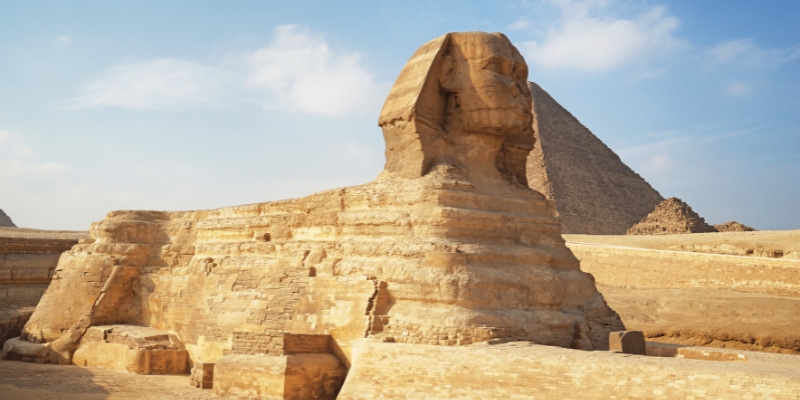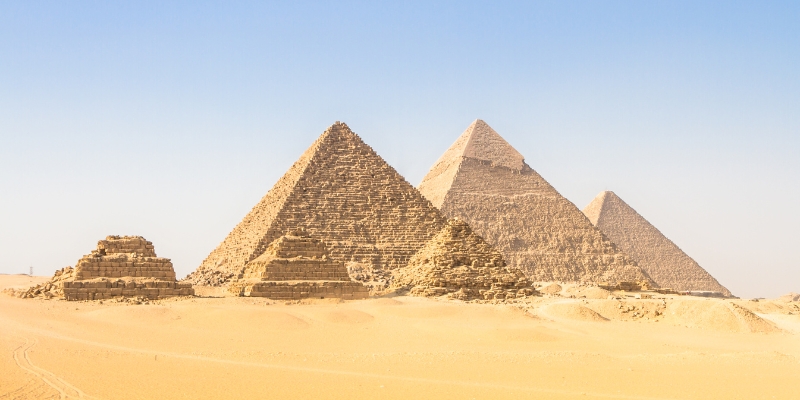The Egyptian pyramids are considered some of the most fascinating and mysterious constructions ever created. Old structures' beauty and mysteries continue to astound. The three most impressive Egyptian structures are Giza, Khafre, and Djoser. The Great Pyramid at Giza is the oldest and most important of the three monuments. Khufu authorized the Great Pyramid's construction. Due to its size and craftsmanship, historians have pondered about it for ages.
The Sphinx defends the limestone Pyramid of Khafre, erected for Pharaoh Khafre. Here, it is proven that ancient Egyptians were skilled builders. The Pyramid of Djoser in Egypt is the earliest large pyramid. The Egyptian monarch of the same name had it erected. It's also crucial for understanding mound evolution. Egyptian builders were innovative and competent, as seen by this building's step pyramid design. These stunning structures showcase Egypt's rich history and culture, and visitors are astounded by the ancient Egyptians' achievements.

8 Most Fascinating Pyramids:
Pyramid of Khufu:
People think the Great Pyramid was named after the Egyptian king Khufu, who ruled during the Fourth Dynasty. The place where Khufu was buried was inside the tower. People often think that Khufu's vizier, Hemiunu, was the one who came up with the idea for the Great Pyramid. To build the building, close to two million stones had to be moved from nearby mines. The three things that went into making the blocks were limestone, granite, and mortar. Because of weathering, the Pyramid of Khufu is now 139 meters (455 feet) tall. However, signs indicate it may have been shorter when it was first built. After getting your Egypt e-visa online, you can see some of the world's most famous pyramids.
Pyramid of Lahun:
Senusret II of the Twelve Dynasties built the pyramid at Lahun (el-Lahun) in 1180 B.C. El-Lahun, whose name in Arabic means "Mouth of the Canal" properly, was in or near water, as its name suggests. Because the pyramid is in bad shape, most of its rooms and tunnels are unavailable and have been torn down.
On the south side of the building was a second entry. However, the main entrance for church events was on the north side of the building. The entry to the Pyramid of Lahun is hidden in the building's foyer on the south side. The Pyramid of Lahun was one of the first pyramids built in Egypt after the building started. In later years, it became clear that keeping old traditions alive wasn't as important as keeping the tomb's contents safe.

Pyramid of Hawara:
After breakfast, depart Cairo for Fayoum, Egypt's oasis. This city is 95 kilometers southwest of Cairo. Your tour will reveal a weird, empty landscape. Visit Karanis on your route to Fayoum Oasis. Many in this historic city revered Sobek, the crocodile deity. Greek and Roman churches were erected there, and their ogival doors may be identified. The magnificent church walls house priests and other church members. You may witness vacant buildings, olive oil presses, and grain crushers at this ancient site.
Pyramid of Teti:
An online visa for Egypt is the ideal option to visit Teti safely and efficiently. The tower is accessible from the north side. The ground-floor entrance door is in the center of the house. On top are flagstones to disguise it. This lovely square church stands above the front entrance. Carved presents into the side rooms to symbolize how people offer gifts. The chapel's back wall basalt has a door, but its use is unknown. The hinges on one door show the church's front entrance is still wood. Only one piece of carved limestone used to create the chapel's ceiling had stars.
Pyramid of Unas:
This pyramid is unique because it was the first pyramid in Egypt to have visa writing. The old pyramid of Unas in Egypt is home to Egyptian texts called the Pyramid Texts. These texts are the oldest and least changed examples of ancient Egyptian funeral writing. There are 712 different thoughts in these books, which are spread out over their pages. The works are a haphazard gathering of different magical formulas that were quickly assembled. The monarch is given these words to help him live happily and peacefully.
Bent Pyramid:
The Bent Pyramid was Egypt's first pyramid. It was dubbed "bent" because it was angled. The Cheops Pyramid is larger than the Meidum Pyramid while rising more slowly. It appears like a step pyramid, but the edges round up as you go up. The Bent Pyramid's front's preservation is impressive. The building's flawless limestone hasn't altered much over time. You won't believe how little the world knows about the Bent Pyramid until you see it. Pre-purchase a ticket to enter the tower.
Red Pyramid:
The pyramidion, also called the capstone, has been dug up, put back together, and put on show in the last few years. It might not be advantageous because its direction differs from the Red Tower's. There are also the ruins of a temple to the east of the pyramid. This temple was probably used for funerals. This is important because Snefru was the first to line up Egyptian buildings with how the sun moved from east to west. Dashur, an area in Egypt, was off-limits for most of its past because of its dangerous landscape.
The Pyramid of Khafre:
The smaller Pyramid of Khafre and the more enormous Pyramid of Khufu are often confused. Khafre is more extended and sharper than other gods. Building height may be significantly enhanced by adding a foundation. The Great Pyramid of Khafre reveals how brilliant ancient Egyptian builders and designers were. How precisely the limestone stones used as pyramid supports were picked shows this. The stones towards the bottom of the Pyramid of Mohamed Khafre are larger and heavier than those at the top.
Conclusion:
In conclusion, Cairo's massive pyramids captivate and hypnotize visitors worldwide. The ancient Egyptians were inventive, skillful, and diligent because they built such spectacular buildings. Looking at the pyramids reveals a long-gone civilization's exciting culture and rich heritage. Pyramids in Egypt, notably the Great Pyramid of Giza and the less famous but equally spectacular pyramids at Dahshur and Saqqara, continue to astound and puzzle travelers of all ages, education levels, and interests. The Great Pyramid of Giza's size and craftsmanship astonish onlookers.
The unknowns regarding their pasts and roles only pique our curiosity. Visiting these pyramids will inspire anybody interested in history, doing new things, or marveling at human creativity. This is because history has all these things. The massive Egyptian structures show that humans have always been fascinated by weird and inventive things.

The Traveler's Chronicle: Unforgettable Places to Visit in Chikmagalur

Finding Your Home in Music City: Where to Stay in Nashville

Campers' Essentials: The Ultimate Packing List

The Ultimate Philippines Travel Guide For 2023

Socializing on Solo Trips: Tips for Meeting New People

Exploring the Enchanting New England States

Which Are The Beautiful Southwest States: An Overview

Guatemala Getaway: Your Travel Guide to this Central American Jewel

Experience the Vibrancy: Top 12 Things to Do in Mumbai

The Ultimate Guide About Road Trip Itinerary to East Glacier National Park

7 The Best Beaches In Italy: An Ultimate Guide
